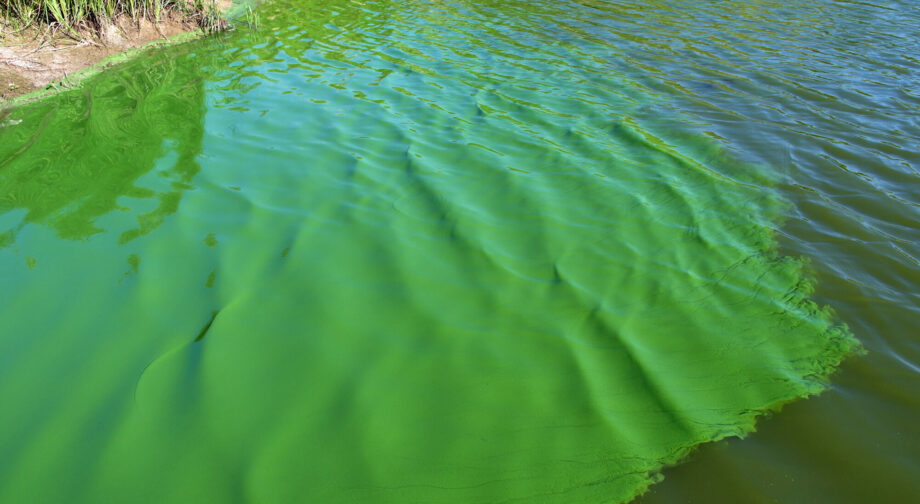November 1, 2022 — Long known for its crystal-clear water, Lake George in New York experienced its first confirmed harmful algal bloom in 2020, turning the lake pea-soup green. Runoff, especially from extreme rainfall events, dumps pollutants such as road salt into the lake, says Eric Siy, president of the nonprofit Lake George Association. Road salt can lurk in soil and streams and on roadsides until it washes into lakes. And it doesn’t just provoke algal blooms.
Earlier this year, an international study in PNAS revealed that aquatic food webs are much more sensitive to salt than previously known. Researchers looked at the impact of salt on plankton living in lake water samples from 16 sites in North America and Europe. They found it takes less than a teaspoon of salt in five gallons (19 liters) of water to harm aquatic life — a concentration lower than recommended limits in every nation in the study.
Rick Relyea, senior endowed chair at Rensselaer Polytechnic Institute’s Darrin Fresh Water Institute and one of the study’s authors, says governments had very little information to go on when they set the current limits.
“With the new data, there’s an opportunity to revisit those thresholds. There’s an opportunity that wasn’t there five years ago, in terms of integrating more data, orders of magnitude more data,” he says.
Balancing Act
New thresholds could be crucial because salt can throw entire ecosystems out of balance. It damages aquatic biodiversity, affecting plankton, fish, amphibians and plants. Salt doesn’t have to kill off a species to change a lake’s ecology. “At some point, things are just going to start dying. By the time you get there, that’s pretty extreme,” says Flora Krivak-Tetley, co-author of several studies on the growing menace of road salt to aquatic ecosystems.
“Zooplankton are the canary in the coal mine because they are the most sensitive organisms in the water. If you protect zooplankton, you often protect other animals.” —Rick Relyea
For example, a decline in one species can lead to an increase in another. This happens with tiny aquatic animals called zooplankton that graze on microscopic plants called phytoplankton. Salt kills or stunts zooplankton, leaving phytoplankton, including cyanobacteria, free to grow. This can lead to harmful algal blooms like Lake George’s in 2020. “If you took cows out of a field, grass would grow more,” explains Relyea.
Salt’s environmental damage extends beyond its direct effects on aquatic organisms. It mobilizes toxic substances such as mercury, lead and radon, threatening water quality for humans and wildlife.
“Soil likes to hang on to positively charged atoms,” says Relyea. “It loves to grab the positively charged sodium, and it lets go of other things that are positively charged, including heavy metals.”
Regulatory Opportunity
“The real question is, what should the threshold be?” says Relyea. He suggests looking at the organisms most impacted by salt to answer that question. “Zooplankton are the canary in the coal mine because they are the most sensitive organisms in the water. If you protect zooplankton, you often protect other animals,” he says.
“This latest understanding of just how little salt can have a huge impact should serve as an impetus for everybody to roll up their sleeves and get this done.” —Eric Siy
Canada has the strictest guidelines limiting salt in freshwater bodies, set at 120 milligrams of chloride per liter (mg/liter). In the U.S., the limit is 230 mg/liter. Most European nations limit chloride in drinking water to 250 mg/liter but are generally silent on protections for freshwater ecosystems. The PNAS study found that the “LC50” for zooplankton — the point where 50% of the population dies, and a common metric of harm — was at or below U.S. and Canadian guidelines in 86% and 73% of cases, respectively. This is consistent with a 2020 Canadian study finding that the LC50 was between 5 and 40 mg/liter.
While updated salt thresholds and regulations would be helpful, communities don’t have to wait for a top-down solution, says Siy from the Lake George Association. “It’s very difficult to regulate stormwater runoff. The EPA has largely thrown up its hands because stormwater is so diffuse,” he says. So the Lake George Association works with local landowners, businesses, and municipalities to reduce salt use and stormwater runoff.
Using a method called sustainable winter management, some towns near Lake George have cut their winter maintenance budgets nearly in half, reducing salt use and labor costs without compromising safety.
“We call road salt the acid rain of our time,” Siy says. “The big difference is, we can solve it where we are.” He adds that the PNAS study provides an incentive for change. “This latest understanding of just how little salt can have a huge impact should serve as an impetus for everybody to roll up their sleeves and get this done.”
Editor’s note: The main photo is by Christian Fischer and the original can be found here.
Related Posts
Ensia shares solutions-focused stories free of charge through our online magazine and partner media. That means audiences around the world have ready access to stories that can — and do — help them shape a better future. If you value our work, please show your support today.
Yes, I'll support Ensia!



